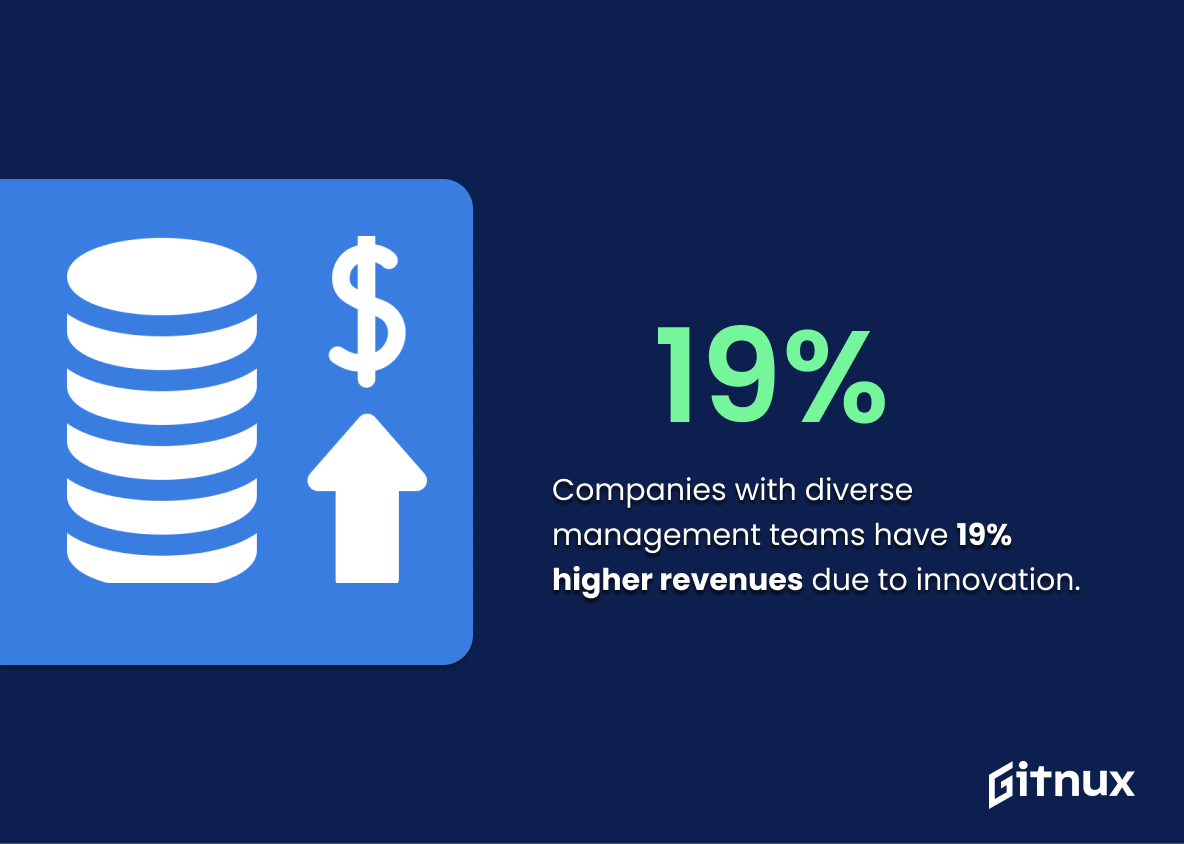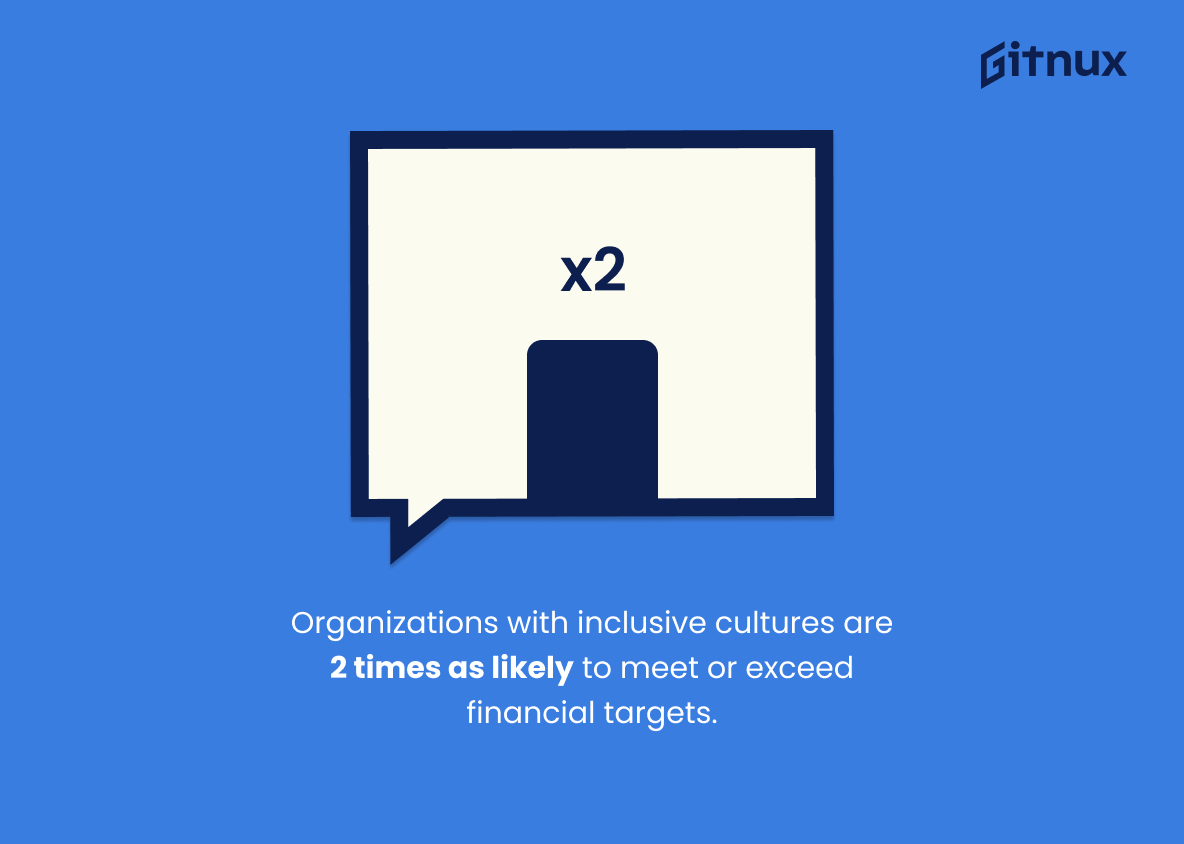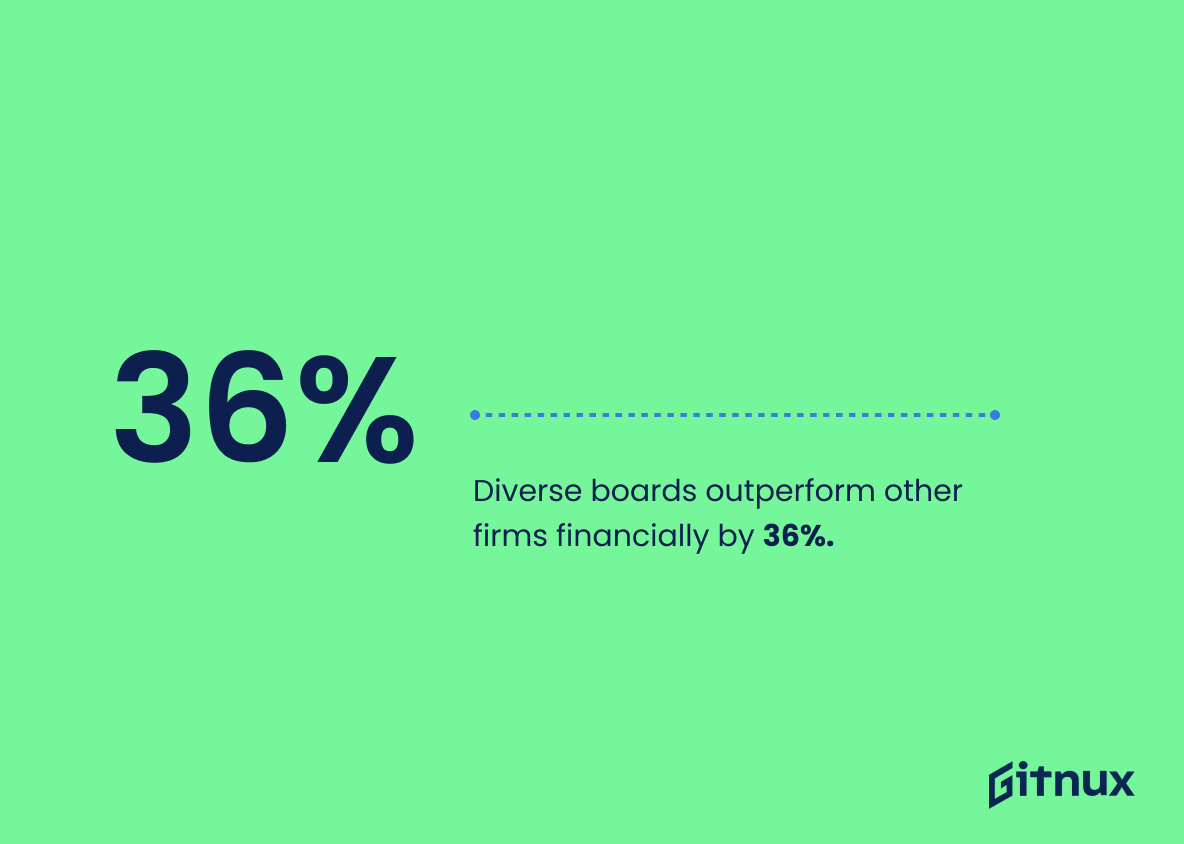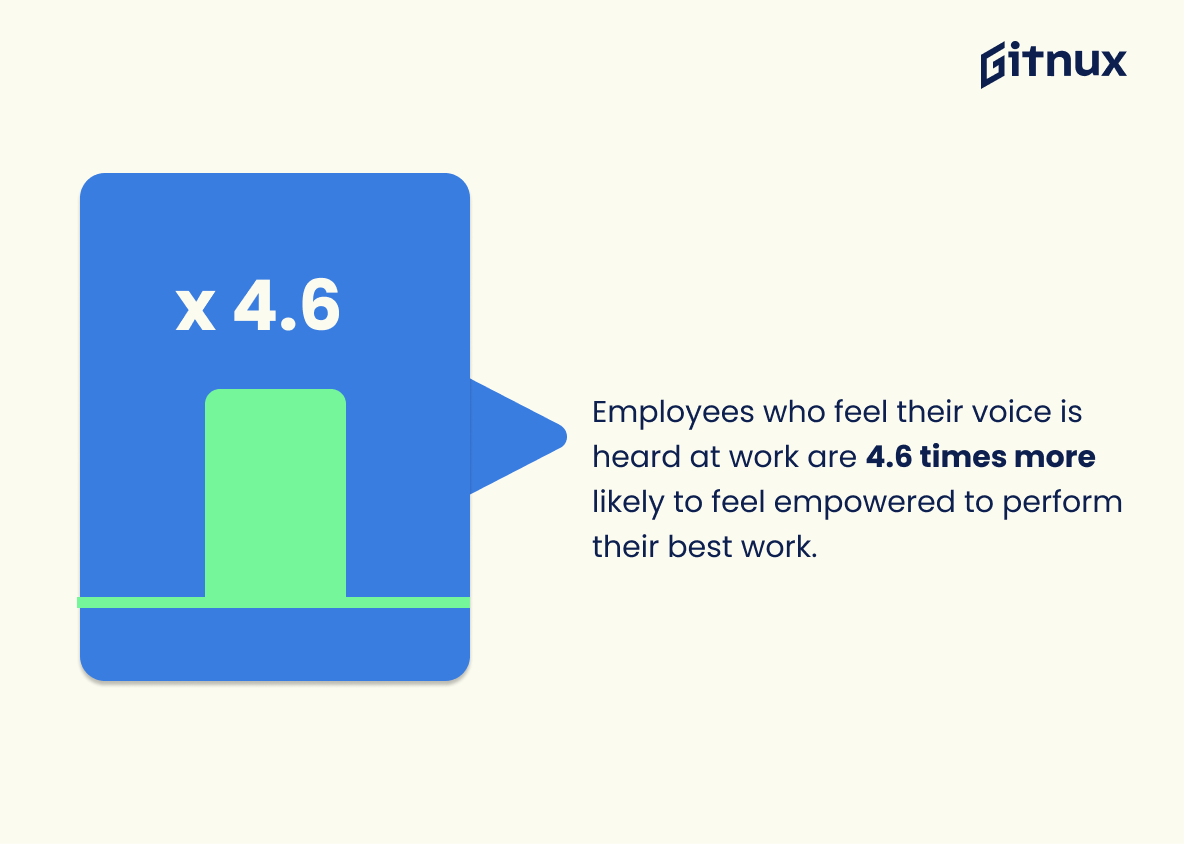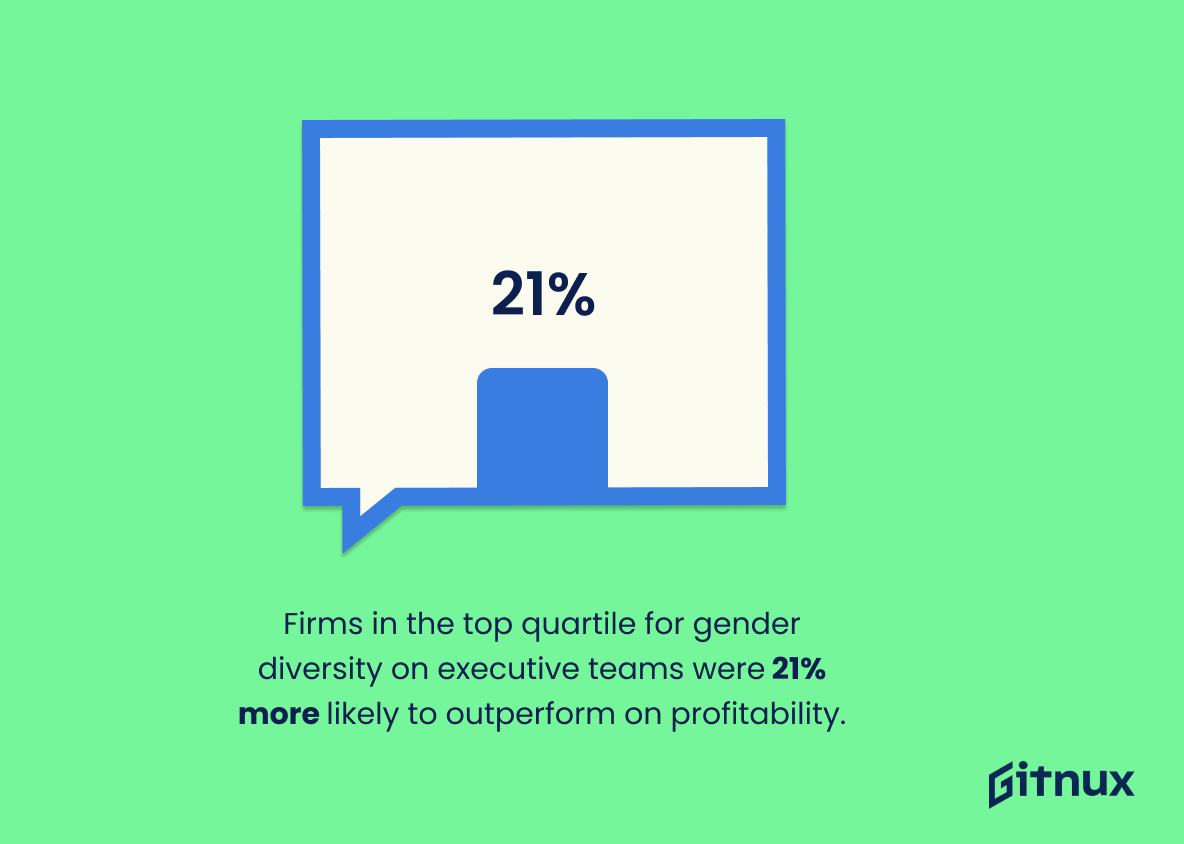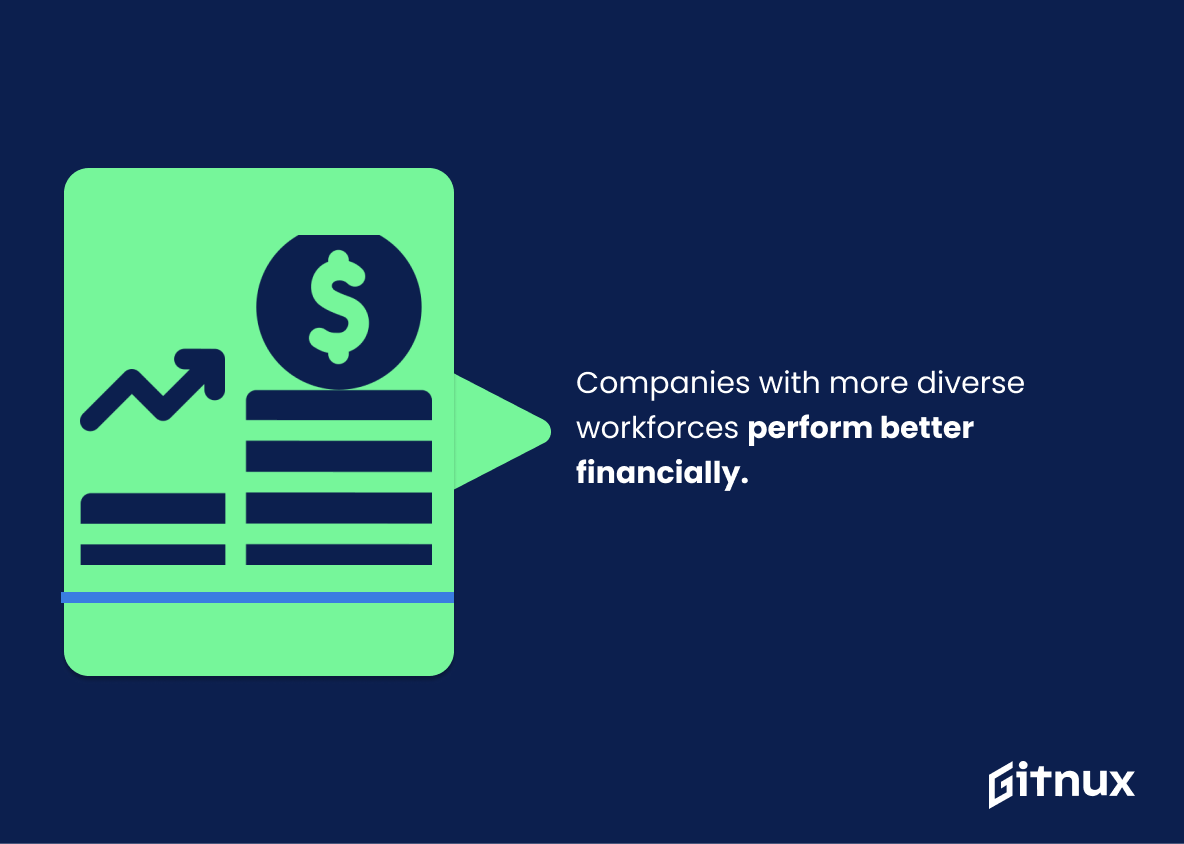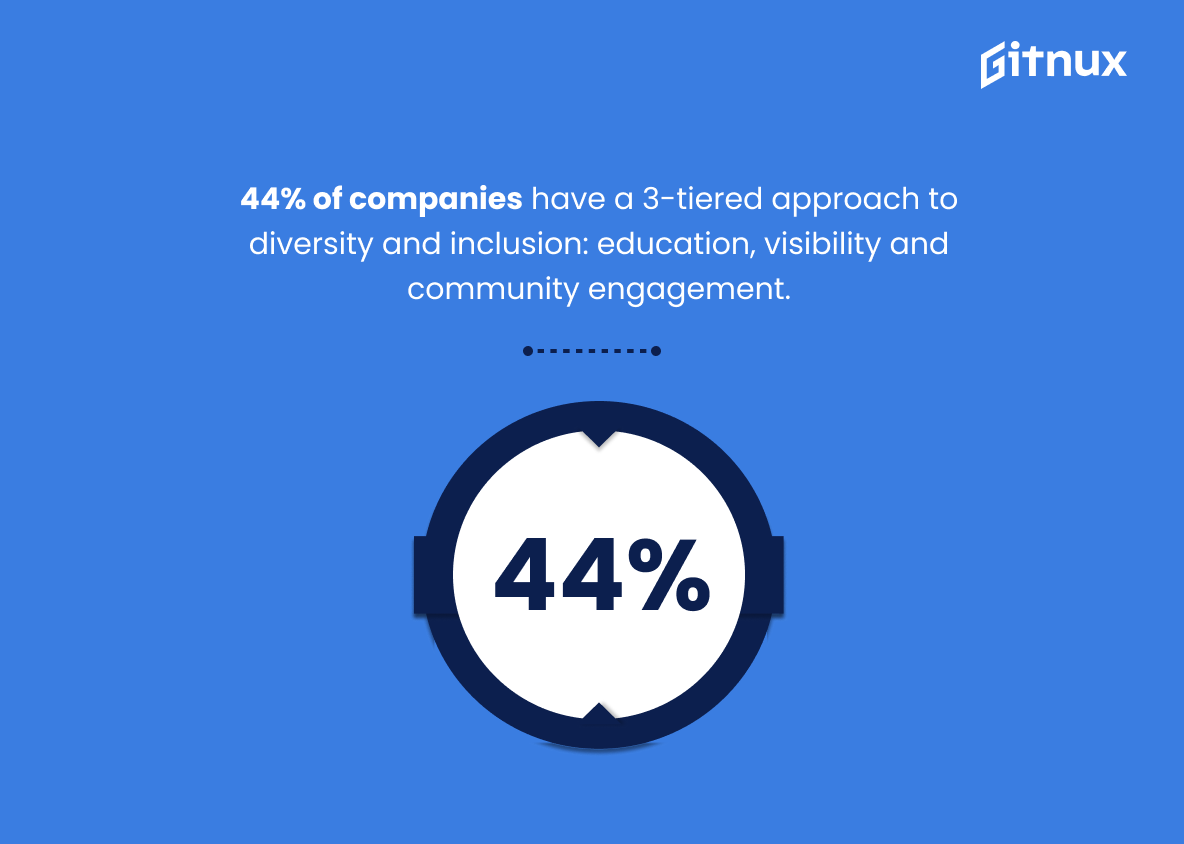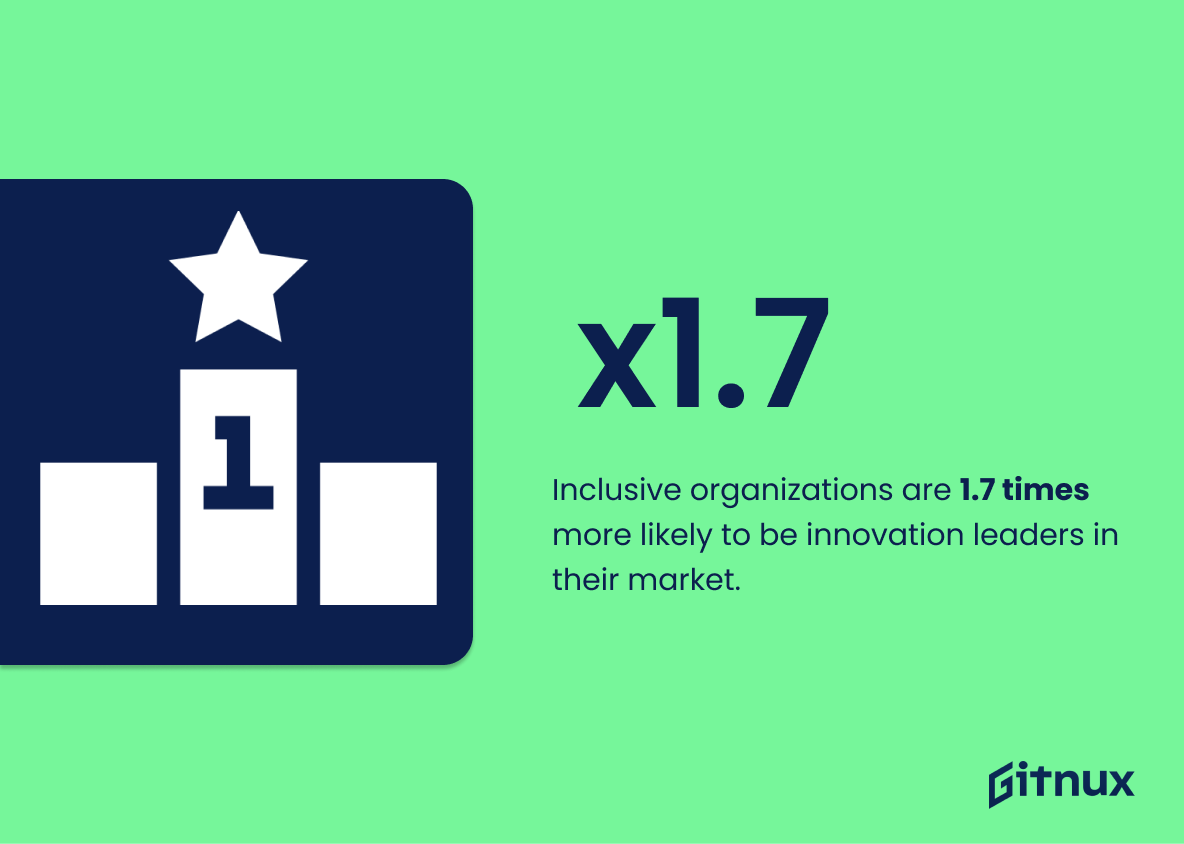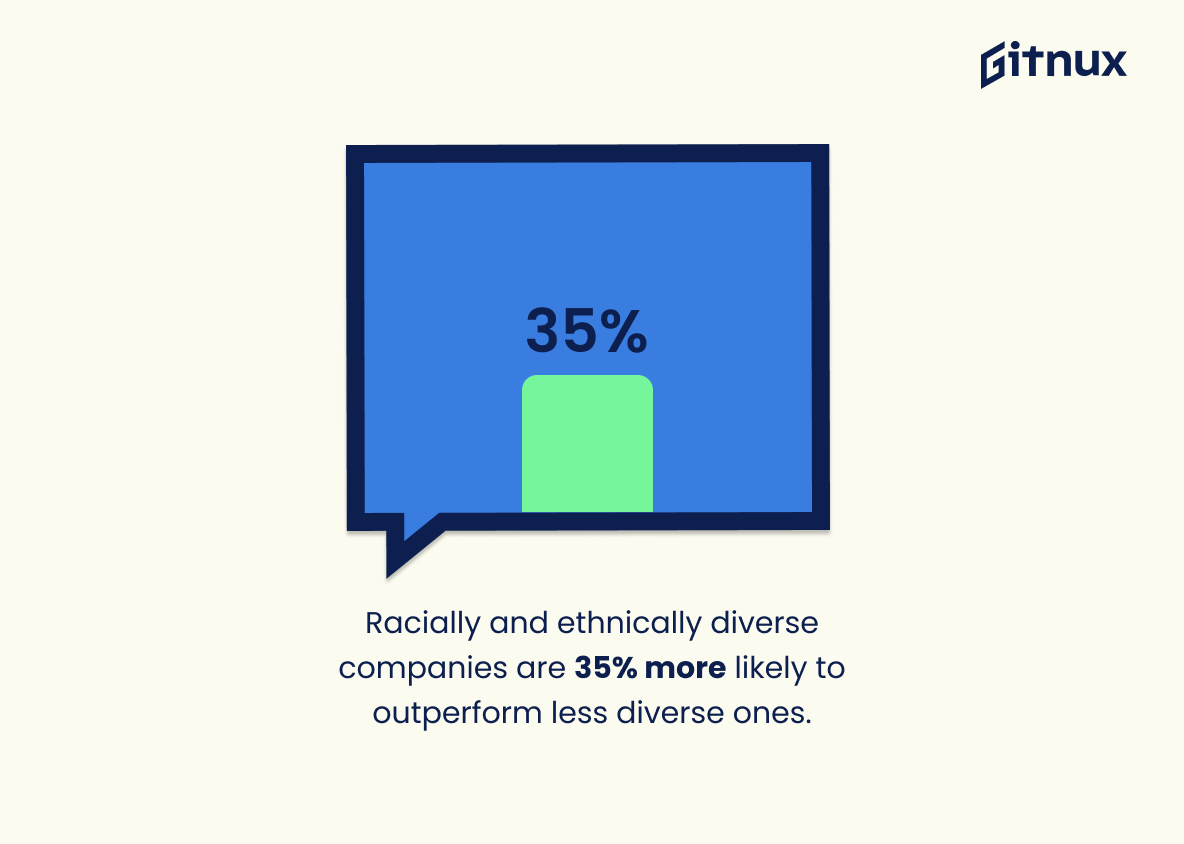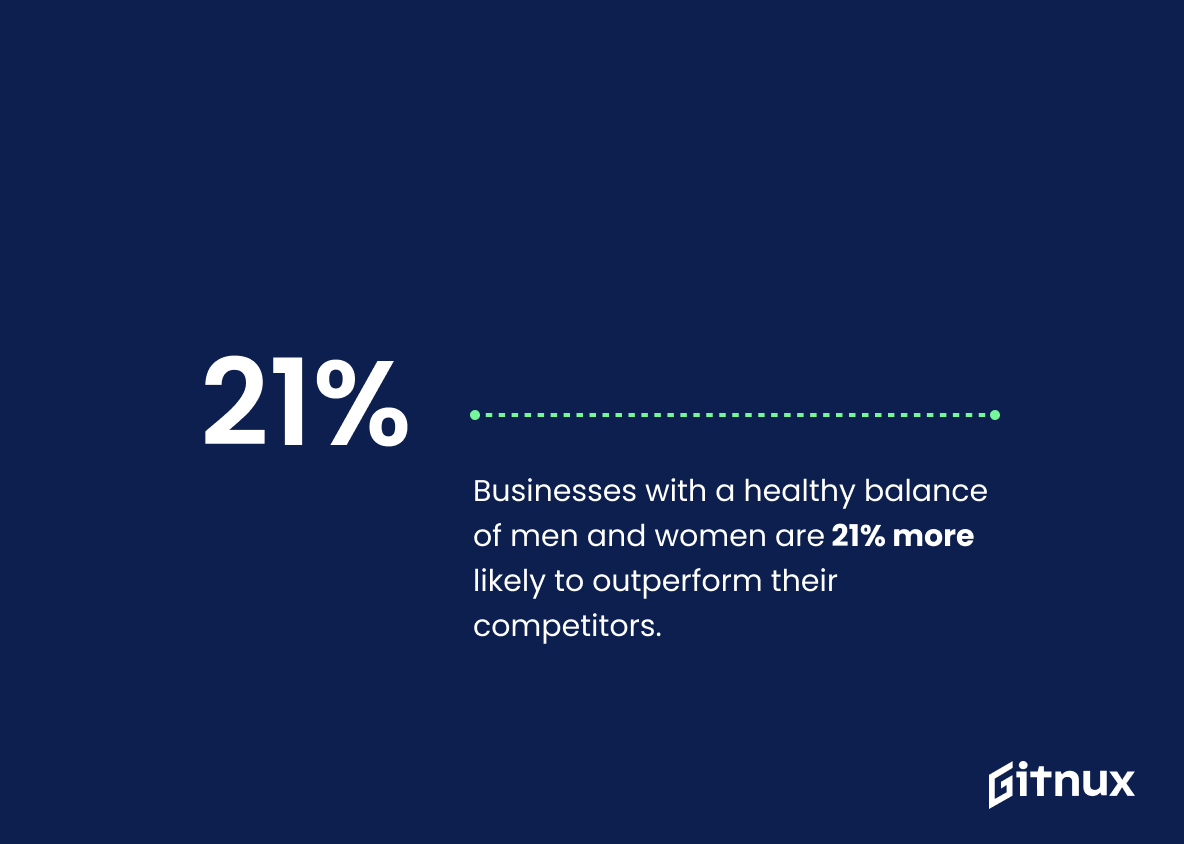In an era where inclusivity and diversity stand central to the functioning of any successful organization, understanding the dynamics of workplace diversity statistics has become imperative. This intriguing world showcases a melange of cultures, experiences, and perspectives transforming our workspaces. This blog post delves deep into these statistics, shedding light on evolving trends and their potential impacts on businesses worldwide. Grasp how shifts in diversity dynamics are challenging traditional norms, uncover transparency reports, and discover how businesses thrive through a culture of inclusivity and respect. Allow us to guide you through the numbers that underline the global workplace’s vibrant tapestry.
The Latest Workplace Diversity Statistics Unveiled
Companies with diverse management teams have 19% higher revenues due to innovation.
In the dynamic storyboard of workplace diversity statistics, the statistic detailing, ‘Companies possessing diverse management teams enjoy a 19% revenue increase due to innovation’ presents a compelling narrative.
This asserts a fascinating interplay between workplace diversity and the creative potency it fuels, dramatically influencing a company’s bottom line. Intricately woven into this unfolding chronicle, this statistic makes for a veritable hero, boldly challenging the norm and showcasing the power of diversity.
It invites the reader to look beyond the conventional wisdom of homogeneous leadership and appreciate the financial merit underpinning diverse viewpoints. It effectively paints diversity not just as an ethical imperative or a cultural requisite, but as a robust catalyst for driving innovation and enhancing revenue potential. In the grand scheme of blogs covering the nuances of workplace diversity, this statistic serves as a pivotal turning point, making readers pause and revisit their preconceived notions about diversity in the workplace.
More importantly, it reiterates that investing in diversity is not just about ticking boxes, seeking representation, or swaying public perception. It lays bare the stark correlation between diverse thought leadership and tangible, financial growth, ensuring meaningful dialogue on diversity extends far beyond just numbers and enters the realm of revenue and long-term business success.
Organizations with inclusive cultures are 2 times as likely to meet or exceed financial targets.
Delving into the substantive realm of workplace diversity statistics, the statistic emphasizing how organizations with inclusive cultures can double the likelihood of meeting or exceeding financial targets becomes a striking highlight, a bold statement with implications twisting and turning on multiple facets of business dynamics.
In a blog post that pulls back the curtain on the intricate interplay of diversity in the workplace, it frames the narrative with concrete evidence, shatters common assumptions and sends a strong message to naysayers. This statistic morphs into a compelling testimony that inclusivity is not just a nod towards social justice but a potent tool for business growth and profitability.
It enthralls readers with an entrenched truth: diversity does not merely paint a pretty picture of variety, it shows its mettle where it matters – the bottom line. Furthermore, it tosses a challenge to organizations still wavering on the edge of embracing inclusivity; are they willing to potentially forgo that sought-after financial growth? It is a persuasive prod to organizations to consider making the leap towards fostering inclusivity, not just out of moral obligation, but for a measurable, far-reaching financial advantage.
So, in the sophisticated symphony of workplace diversity statistics, this particular note resonates powerfully, directing the discourse towards tangible benefits and enforcing the merits of inclusion in undeniable economic terms.
Diverse boards outperform other firms financially by 36%.
Spotlighting the striking figure of a 36% financial edge, it becomes clear how interlacing boardroom diversity and robust financial performance dance together in a powerful tango. Within the wide continuum of workplace diversity statistics, this powerful insight punctuates the compelling rationale behind fostering diversity at board level. It seemingly spins a tale where diverse perspectives spruce up decision-making processes, leading to more innovative solutions that could command industry leadership. Exhibiting both – the health of the corporate bottom line and societal progress, this statistic in the blog post becomes a deep-dyed tapestry of thought, speaking volumes about the financial implications of embracing diversity.
Employees who feel their voice is heard at work are 4.6 times more likely to feel empowered to perform their best work.
Bridging the gap between this statistic and its importance in a blog post about Workplace Diversity Statistics, we must cast some light on the intricate dance of employee engagement, retention, and, most importantly, empowerment. Imagine an orchestra where only half the instruments are allowed to play while the rest are muted. You’d be missing out on a harmonic melody, wouldn’t you? That’s what happens when diverse voices in a workspace are silenced or ignored.
The statistic serves as a potent reminder showcasing that when employees sense that their viewpoints are being considered, they are likely to feel empowered, driving them to deliver their best work. This doesn’t only cultivate an efficient work environment, but resonates with an orchestra playing a beautiful symphony, where everyone’s contributing to the collective outcome. This is diversity at work, honoring the variety of voices, experiences, and expertise. It emboldens individuals, fosters better team performance, and thus strikes the keynote in the Symphony of Diversity in the Workplace.
45% of American workers reported experiencing discrimination and/or harassment in the past year at their workplace.
Employing this striking revelation about working environments, that a substantive 45% of American workers have encountered discrimination and/or harassment in their previous year at their workplace, holds luminous significance when investigating Workplace Diversity Statistics. This figure energizes the conversation around diversity and inclusion with a touch of urgency; it’s not just about representation, but instilling an inclusive culture that repels discrimination and harassment. It equates to almost half of the American workforce and accentuates the necessity for an immediate addressing of workplace policies to curb this alarming statistic, making our discourse on diversity not just timely, but critical.
Diversity initiatives have a satisfaction rate of 92.8% among the public sector compared to 76.3% in the private.
In the realm of Workplace Diversity Statistics, this figure yields a glaring spotlight on the positive relationship between diversity initiatives and satisfaction ratios within different sectors. 92.8% satisfaction rate within the public sector showcases the effectiveness of diversity programs in attracting, retaining, and engaging a vibrant constellation of talents who bring a diverse set of ideas, creativity and solutions to the table, enriching the public sector. On the flip side, the more modest 76.3% rate in the private sector provides a compelling snapshot, signaling a corridor of opportunities for the private entities to improve their diversity strategies. Intriguingly, this disparity underscores the necessity for knowledge sharing between the sectors, to leverage best practices and achieve the universal goal of an inclusive, diverse and satisfied workplace.
Firms in the top quartile for gender diversity on executive teams were 21% more likely to outperform on profitability.
Exploring the golden nugget of wisdom hidden in the statistic – ‘Firms in the top quartile for gender diversity on executive teams were 21% more likely to outperform on profitability’, paints an impressive panorama of the corporate world. Under the spotlight of this statistic, the storyline of our blog on Workplace Diversity Statistics takes an intriguing turn. It amplifies the undeniably strong correlation between gender diversity in leadership roles and enhanced profitability, showing that inclusive decision-making processes are not just a social obligation but a potent move for business growth.
This statistic injects credibility to the audacious claim that diversity isn’t merely a buzzword, but a robust catalyst for innovation and a healthy bottom line. It ignites the realization that a gender-diverse executive team isn’t just a good look for company culture, but a game-changer for financial performance. It propels the narrative that businesses prioritizing gender diversity at the executive level are not only weaving an inclusive tapestry of perspectives but also making a sound decision with vital economic impacts.
Suffice to say, this statistic paints the picture in bold, undeniable strokes – gender diversity in executive teams is a surefire strategy to hit the high notes in profitability. Hence, as we tread the path of this blog post on Workplace Diversity Statistics, let this statistic serve as compelling evidence supporting our mantra: Diversity does make a difference.
Organizations with higher than average diversity had 19% higher innovation revenues.
When weaving the fabric of a successful organization, diversity appears to be a golden thread. An intriguing statistical nugget such as “Organizations with higher than average diversity had 19% higher innovation revenues” can provide a vibrant splash of color at the intersection of diversity and innovation. Appropriately illuminating, in the context of a blog post about Workplace Diversity Statistics, it serves as an empirical evidence to the power diverse teams hold in invigorating the inventive muscles of a business. As business communities across the globe squint towards innovation as the magic key to the treasure chest of growth, it’s now illuminated that diversity could indeed serve to turn the lock, and stats like these shout out this very fact from the digital rooftops.
Companies with more diverse workforces perform better financially.
In an ever-evolving business landscape, the statistic that companies with more diverse workforces perform better financially pepper a significant thought to consider. In the realm of workplace diversity statistics, this is the luscious cherry on top. Highlighting the correlation between diversity and financial performance, it sends out a loud and clear message. It spotlights the fact that an inclusive environment isn’t merely a beautiful depiction of varied cultures but also a powerhouse for monetary triumphs. Companies willing to shake the traditional homogeneity are not just brandishing their corporate social responsibility but also affirmatively amplifying their profit margins.
Aiming a spotlight at the financial benefits of diversity, this statistic acts as a silent influencer encouraging the corporate community to break free from the traditional employee molds. Fostering an environment rich in different perspectives, experiences, and backgrounds breed innovation due to the variety of distinct ideas. This step out from uniformity is the secret recipe to a growing, thriving business.
So, rather than viewing diversity as a compliance obligation, this intriguing number prompts companies to perceive it as a business growth strategy. Therefore, every time a company initiates a step towards inclusivity, it’s not just embracing variations but potentially unlocking another level of performance and financial success.
44% of companies have a 3-tiered approach to diversity and inclusion: education, visibility and community engagement.
Highlighting that nearly half of all companies employ a 3-tiered approach for diversity and inclusion underscores the significant shift in how businesses are operating. It demonstrates that the corporate world is increasingly understanding the importance of varied approaches including education, visibility, and community engagement to foster diversity and inclusion. This multifaceted strategy reinforces the idea that diversity is not a singular issue, but rather an interconnected web of factors, thereby highlighting its place as a top priority in the modern workspace. Hence, in a blog post about Workplace Diversity Statistics, the readers would realize that to truly cultivate an inclusive environment, each layer of this three-pronged approach must be properly addressed and implemented.
Inclusive organizations are 1.7 times more likely to be innovation leaders in their market.
Illustrating the undeniable connection between diversity and innovation, the figure that inclusive organizations stand 1.7 times higher chance of being market frontrunners in innovation is nothing short of compelling. In a world that thrives on continuous innovation, businesses can hardly afford to overlook this compelling advantage of inclusivity.
Within the sphere of a blog post that explores the statistics surrounding Workplace Diversity, this fact amps up the conversation, specifically focusing on the crucial role inclusivity plays in steering innovation. The numbers silently yet mightily vouch for the strength that diversity brings in terms of fresh ideas and perspectives, contributing to a vibrant culture of creativity and innovation. Consequently, increased innovation potential propels these organizations to be market leaders, underlining diversity not as an ‘optional nice-to-have’, but as a ‘crucial must-have’ for any company aspiring for market leadership.
Racially and ethnically diverse companies are 35% more likely to outperform less diverse ones.
Embracing the rainbow of racial and ethnic diversity in businesses appears to be more than just a strive for inclusivity or a nod towards social justice. Indeed, the statistic that diverse companies outperform their less diverse counterparts by a whopping 35% paints a definite picture of the considerable economic advantage that comes along with embracing diversity. This number makes a strong case in the narrative for workplace diversity, showcasing it as not just a moral imperative, but a key ingredient to a thriving business. Hence, cultivating diversity becomes a strategic approach maneuvering the competitive arena of today’s marketplace.
Businesses with a healthy balance of men and women are 21% more likely to outperform their competitors.
As we dim the spotlight on Workplace Diversity Statistics, an intriguing figure catches the eye. Businesses boasting a gender-balanced workforce have a 21% increased likelihood of surpassing their competitors. This number underscores the tangible value that diversity brings to the business landscape. It isn’t simply about ticking the correct corporate social responsibility boxes or following trending social ideals. It’s about fostering a dynamic environment that infuses different perspectives, approaches, and skills, all essential factors in driving innovation and enhancing problem-solving capabilities. Essentially, when businesses invest in achieving gender balance, they gain a distinct competitive edge – an advantage reflected in their superior performance. This statistic reaffirms that diversity isn’t merely a feel-good move, it’s a proven growth strategy.
Conclusion
In sum, workplace diversity statistics act as a microscope focused on an organization, exposing its inner workings and underscoring the notable rewards of adopting a diverse workforce. The statistics show it is an undeniable multiplier of innovation, increased profits, and better decision-making. The undeniable impact of diversity on productivity and profitability makes promoting diversity and inclusion more than just a moral obligation, but a strategic necessity. These diverse organizations will not only be at the forefront of societal change but also lead in terms of growth and progress in the corporate world. Therefore, employers should aim to build diverse and inclusive workplaces, as it will only pave the way for a more harmonious and prosperous future. Thus, workplace diversity is not a trend that is fading away, but rather a business model that has arrived to stay and shape the future of work.
References
0. – https://www.hrsource.org
1. – https://www.www2.deloitte.com
2. – https://www.www.mckinsey.com
3. – https://www.www.bcg.com
4. – https://www.www.forbes.com
5. – https://www.hbr.org
6. – https://www.builtin.com
7. – https://www.www.salesforce.com
